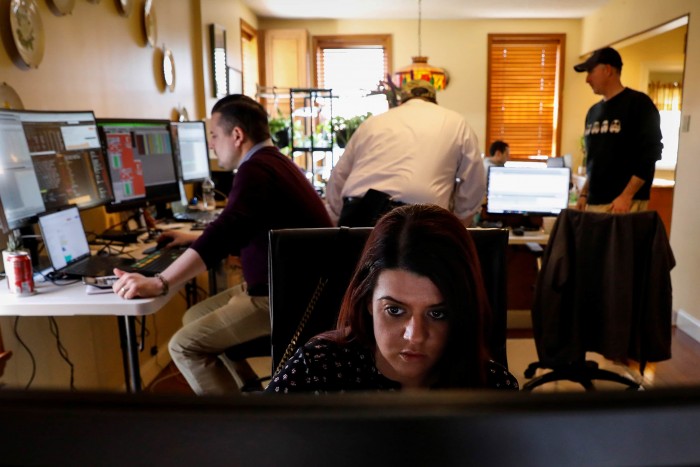America’s Shift to Online
COVID-19 has introduced the concept of working from home to many who have never experienced it. But, different industry needs, varying family and gender roles, and a need for interaction may explain why it wasn’t already the norm.

Thea D’Adamo, Head of Options Execution at TradeMas Inc., works with fellow NYSE-AMEX floor traders in an off-site trading office they built in her home when the New York Stock Exchange (NYSE) closed, due to the outbreak of the coronavirus disease (COVID-19), in the Brooklyn borough of New York City, U.S., March 26, 2020. Brendan McDermid/Reuters
In the past two weeks, residents in the United States have been barricaded inside their homes by COVID-19, the novel coronavirus that surfaced in the fall of 2019.
Although COVID-19 was first discovered in China, its global spread has been swift, as travelers and trade have carried the virus between and within countries. To insulate themselves from contagion, individuals and businesses across the globe have implemented measures designed to limit human-to-human contact.
In the United States, the result has been a shift to an economy largely housed online. Fitness studios like YogaWorks are livestreaming classes over YouTube, doctors’ offices are offering video consultations, and schools and universities are holding lectures over Zoom.
Though the shift to this “e-economy” has certainly elicited a craving for human interaction among consumers, it has also given them an unprecedented ability to procure services virtually. For some, this is a flexibility that would prove useful if continued post-COVID-19. When the e-economy is thought of in this way, it’s easy to ask: why haven’t businesses gone online sooner?
Yet, while the March 2020 shift to online is a testament to American adaptation, ingenuity, and technology, its narrative is selective. Though some businesses have been able to survive virtually—thanks to employees who have begun to work from home (WFH)—essential businesses continue to require physical employee presence, and non-essential businesses that are unable to operate under a WFH system have enacted widespread layoffs. The narrative of the e-economy also excludes those who are struggling with balancing WFH with sick relatives, or with children untethered from their usual support systems of schools and daycares.
White-Collar Work
It is true that the percentage of the U.S. workforce that completes some or all of its work at home has seen an increase before the corona crisis—from 22 percent in 2016 to almost 25 percent in 2017. “Generally people view working from home as a way to provide greater autonomy and flexibility,” says Paula Caligiuri, who specializes in organizational psychology and international business. “There’s already been kind of a movement towards that anyhow,” she continues.
But, the WFH movement during this time was mainly a white-collar phenomenon. In 2017, 51 percent of WFH Americans were in management, business, and financial operations occupations. A further 38 percent had “professional and related” jobs, like legal, accounting, and data processing positions.
In these sectors, many businesses were already equipped with technology to facilitate online work; Google Drive is a mainstay for housing data in many workplaces, and several universities offered online course options before the outbreak of COVID-19. Additionally, video-chat software like Skype and Zoom has enabled employees who worked remotely before the COVID-19 crisis to create and join meetings from their living rooms.
Because of this pre-existing infrastructure, many workplaces were able to shift their operations completely online with more ease than their blue-collar counterparts. Thus, “White-collar workers are going to suffer much less than blue-collar workers as a result of [coronavirus restrictions],” Barry Bluestone, founding dean of the School of Public Policy and Urban Affairs at Northeastern University explains.
“We’ve done that at Northeastern University for years, so for many of our faculty it wasn’t much of a transition,” Bluestone acknowledges. “We were already teaching a number of courses online, because we have students not just in Boston but around the world in some of our courses.”
A Bleak Reality
In many other professions, WFH is not an option; manufacturing, construction, hospitality, food service, emergency response, retail, and many healthcare jobs—and that’s just part of the list—all require human presence. WFH employees in farming, construction, maintenance, and transportation only made up 2–7 percent of the broader WFH population each in 2017.
Though some gains have been made in distancing human-to-human interaction in the service sector—e.g., delivering food and retail goods instead of allowing customers to come to the store—humans are still needed to drive cars, make food, and pack boxes. In these circumstances, no technology exists to take the human out of the equation. We don’t yet have fully autonomous cars, and though robots have been used to pack boxes at Amazon, they’re not commonplace.
Workers without the ability to go online face a catch 22; they’re characterized as either “nonessential”, and face layoffs as their businesses close, or “essential”, and must go to work and face a pandemic or stay home and face similar unemployment. Some essential workers, like employees at Amazon and Instacart, have tried to mitigate the danger by going on strike as a means to obtain hazard pay and personal protective equipment.
On March 19, the U.S. Department of Labor reported 281,000 new unemployment claims in that week, mostly in the service, transportation, and warehousing industries—a 30 percent increase from the week before. In this context, James Bullard, President of the Federal Reserve Bank of St. Louis, predicted to Bloomberg that the national unemployment rate could reach 30 percent in the second quarter. For contrast, the rate reported by the Bureau of Labor Statistics for February of 2020 was 3.5 percent.
“I wouldn’t be surprised if 90 percent or more of manufacturing employees are now on layoff. The other 10 percent are in urgent industries, trying to make masks and ventilators,” predicts Bluestone.
Oh, the Humanity!
Even within the population that has shifted its work operations to home, huge variations exist. Individuals with children are trying to find time to work between attending to their needs—who, now that schools have gone online, may be looking for other outlets into which to direct their energy. Parents have found themselves promoted, and now occupy the additional roles of teacher, chef, and daycare worker.
Vox writer Cheryl Wischhover points out that parents face different obstacles depending on the age of their children—toddlers and young children require constant care, while teenagers yearn for freedom and resent being sequestered with their families. “My two teen boys are resentful that they have to stay inside, and they miss their friends and activities. My 11th-grader’s SAT, which he’d been studying for for months, was canceled,” Wischhover writes—adding anxiety over an uncertain future into the mix.
Parents of children with disabilities find themselves at an even more complicated juncture. In this case, parents absorb the responsibilities of a whole team of special education workers that a child may require; one child may need “a vision therapist, speech therapist, occupational therapist, learning behavioral therapist and various teachers in the classroom, adaptive special education, and special subjects,” as one eighth-grader referenced in a recent article for The Washington Post does.
The nonprofit CARE and the International Rescue Committee (IRC) recently published a study, “Global Rapid Gender Analysis for COVID-19”, that argues that the bulk of this “unpaid care work”—which includes caring for sick family members as well as children completing online schooling—is absorbed by women. In fact, women execute three times as much care work as men do. This disparity replicates itself in the health professions, where female responders “face a double care-giving burden—one at work, and one at home.”
Women are also increasingly vulnerable to domestic violence, as they are in some cases quarantined with their abusers. “Individuals, particularly women, are essentially trapped with their abuser with no physical respite from the abusive relationship,” CARE and the IRC write in their report on gender and COVID-19. The organizations report that 35 percent of women globally face domestic violence under non-coronavirus conditions—a number which is compounded during crisis like health pandemics by economic stress and increased anxiety in addition to the quarantine conditions of COVID-19. Domestic abuse—or “intimate terrorism”, as it is sometimes called—is also projected onto children; one Texas children’s hospital reports an increase in child abuse cases from eight per month to six per week. For individuals who wrestle with abuse, WFH is a nightmare scenario—commuting to work may be a welcome respite.
Meanwhile, single Americans who live alone are truly learning the meaning of “isolation”. Humans crave interaction; in fact, various studies have demonstrated that loneliness poses tangible health risks. In the Journal of Health and Social Behavior, Debra Umberson and Jennifer Karas Montez warn of loneliness-related ailments ranging from heart attacks to high blood pressure.
This may be another reason that the WFH movement had not completely taken over before COVID-19. Part of WFH movement’s success is that, under normal conditions, it allows employees to retain the ability to create social connections separate from their work. As Melanie Pinola writes for the New York Times, it is not uncommon for WFH employees to steal slivers of time between meetings for grocery shopping, coffee runs, or yoga class. It’s not technologically feasible right now for the service sector to go completely online—i.e., for drive-throughs to be manned by robots or supermarkets to restrict their services to drone delivery. But, the human need for interaction could be one factor that restricts us from getting there.
“During your breaks, unchain yourself from your desk and take a walk and talk to another human being, such as a grocery clerk, a crossing guard, or a waiter (if you go out for lunch),” Pinola urges employees making the transition to WFH.
Humans are accustomed to a life that allows them to socialize as consumers; as modes of consumer interaction are restricted by COVID-19, we already see this stress on a smaller scale. In an interview with WBUR 90.9, former Surgeon General Vivek Murphy, even warns of a “social recession”, which he defines as “an increase in loneliness and the health consequences thereof as people become more and more isolated from each other.”
“How to Stay Sane in Quarantine”
To combat the psychological drawbacks of the pandemic-induced dearth of face-to-face interaction, WFH employees have been advised to replicate office conditions in their homes. The wellness sections of almost every major publication have been working overtime to coach new WFH employees on their transition. “Have set wake-up times, ‘office hours,’ free time, meal times, and exercise times. Take a shower and get fully dressed in the morning. The more we can stick to a routine, the better off we will be mentally and physically,” Stephanie Sarkis counsels for Forbes. The title of her article—“How to Stay Sane in Quarantine”—makes the necessity of structure clear.
Getting “dolled up” is even a mainstay of “How to Have a Successful Virtual Happy Hour”. In the article, by Anna Goldfarb for the New York Times, a reader says that getting dressed (as opposed to staying in your wine-stained pajama-turned-work pants) “gave her a sense of normalcy.”
Psychology and business expert Caligiuri agrees that routines are useful in minimizing complexity; they “free up some bandwidth cognitively and emotionally.” So, in high-stress situations like this one, “it’s highly recommended that individuals get into habits very quickly, treating their home space—whatever piece of the kitchen table they’re working from—as going into the office and setting up a routine for themselves as if they were at work,” she says.
Now that the United States has some muscle memory for what a predominantly e-economy would look like, some modes of working, learning, and interacting online might be retained post-COVID-19, Bluestone and Caligiuri agree. But, “there will always be a place for face-to-face interaction,” Caligiuri speculates. “My sense is that we’ll never be at the same capacity of people commuting into a place called a ‘company’, an ‘organization’, an ‘office’—a physical location. I don’t think it will go back fully to that, but I don’t think it will stay as extreme as it is right now.”
Sydney Wise is contributing editor at the Cairo Review of Global Affairs. Her past work has been published at the Boston Consortium for Arab Region Studies. On Twitter: @sydneyywisee
Read More



